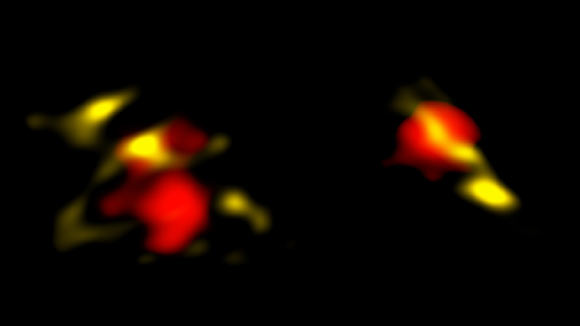When the Universe was only 10% of its current age, most of the early galaxies experienced a so-called ‘growth spur.’ During this time, the galaxies built up most of their stellar mass and other properties, such as dust, heavy element content, and spiral-disk shapes. In a survey called ALPINE (the ALMA Large Program to Investigate C+ at Early Times), astronomers used the Atacama Large Millimeter/submillimeter Array (ALMA) to observe 118 early galaxies experiencing a growth spurt.

An artist’s impression of a dusty, rotating distant galaxy in the early Universe: red color represents gas, and blue/brown represents dust as seen in radio waves with ALMA; many other galaxies are visible in the background, based on optical data from ESO’s Very Large Telescope and NAOJ’s Subaru Telescope. Image credit: B. Saxton / NRAO / AUI / NSF / ESO / NASA / STScI / NAOJ / Subaru.
Galaxies are considered more ‘mature’ than ‘primordial’ when they contain a significant amount of dust and heavy elements — by-products of dying stars.
But galaxies in the early Universe have not had much time to build stars yet, so astronomers don’t expect to see much dust or heavy elements there either.
“To our surprise, many of them were much more mature than we had expected,” said Dr. Andreas Faisst, an astronomer in the Infrared Processing and Analysis Center (IPAC) at Caltech.
“We didn’t expect to see so much dust and heavy elements in these distant galaxies.”
“From previous studies, we understood that such young galaxies are dust-poor,” said Dr. Daniel Schaerer, an astronomer at the University of Geneva.
“However, we find around 20% of the galaxies that assembled during this early epoch are already very dusty and a significant fraction of the ultraviolet light from newborn stars is already hidden by this dust.”
Many of the galaxies were also considered to be relatively grown-up because they showed a diversity in their structures, including the first signs of rotationally supported disks — which may later lead to galaxies with a spiral structure as is observed in galaxies such as our Milky Way.
“We see many galaxies that are colliding, but we also see a number of them rotating in an orderly fashion with no signs of collisions,” said Dr. John Silverman, an astronomer in the Kavli Institute for the Physics and Mathematics of the Universe.

These are two of the galaxies in the early Universe that ALMA observed in radio waves; these galaxies are considered more ‘mature’ than ‘primordial’ because they contain large amounts of dust (yellow); ALMA also revealed gas (red), which is used to measure the obscured star-formation and motions in the galaxies. Image credit: B. Saxton / NRAO / AUI / NSF / ESO / NASA / STScI / NAOJ / ALPINE Team.
ALPINE is the first survey that enabled astronomers to study a significant number of galaxies in the early Universe, and it shows that they might evolve faster than expected.
“With ALMA we discovered a few distant galaxies for the first time,” said Dr. Lin Yan, an astronomer at Caltech.
“We call these ‘Hubble-dark’ galaxies as they could not be detected even with the NASA/ESA Hubble Space Telescope.”
“Such a large and complex survey is only possible thanks to the collaboration between multiple institutes across the globe,” said Dr. Matthieu Béthermin, an astronomer at the Laboratoire d’Astrophysique de Marseille.
To learn more about distant galaxies, the astronomers plan to point ALMA at individual galaxies for a longer time.
“We want to see exactly where the dust is and how the gas moves around,” said Dr. Paolo Cassata, an astronomer at the University of Padua.
“We also want to compare the dusty galaxies to others at the same distance and figure out if there might be something special about their environments.”







